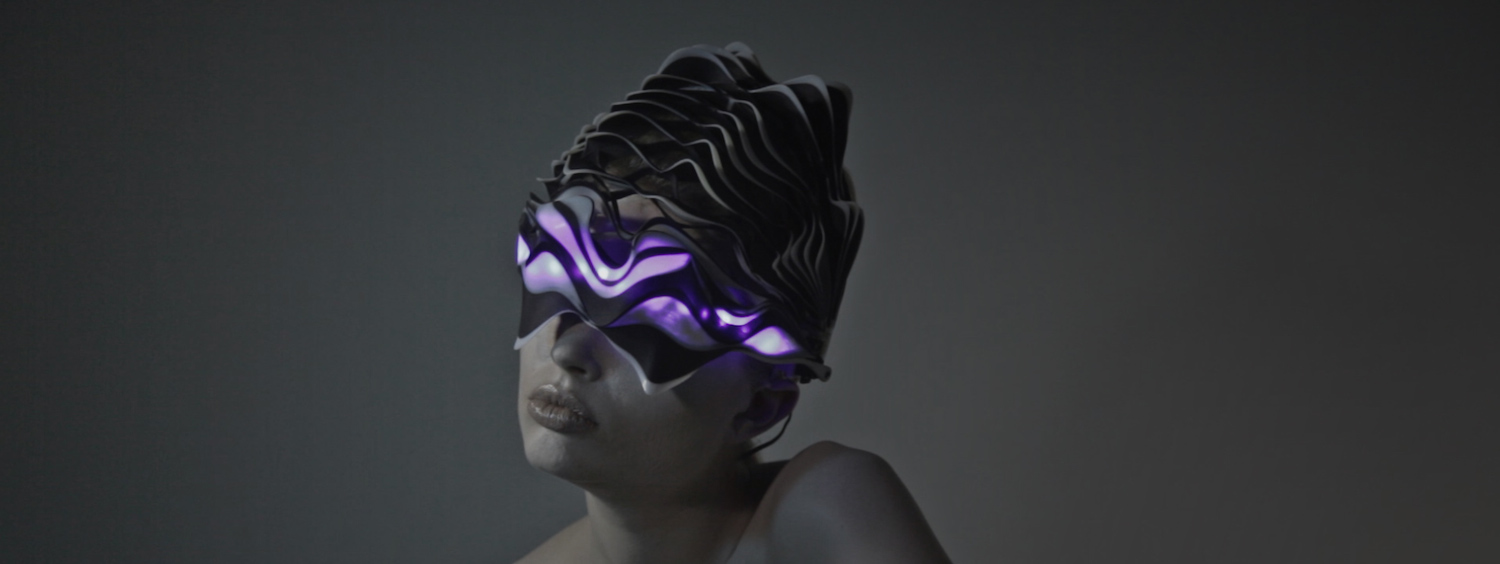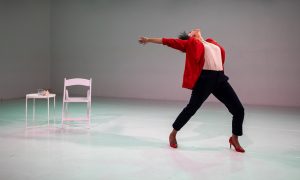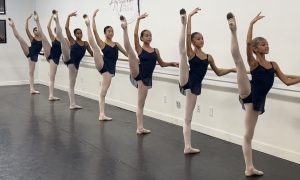Dancers these days are enjoying an ever-enlarging toy box of intriguing digital playthings as designers develop sensors that can be embedded in pointe shoes, clipped to tunics, implanted in headgear, and tucked up tutus. These allow performers to interact with software, trigger lights and sound, create computer-screen calligraphies, and more.
Chinese researchers imagine a classroom application. They claim that sensors in dance shoes can determine whether the dancer’s technique is up to standard—relieving teachers of this chore.
Choreographers and software designers are flooding stages with digital projections, making them look like 3-D computer screens. Swirling, pulsing virtual environments surround performers in works like those from dance company Chunky Move in Australia, Japanese dancer Yoko Ando, and digital artists Adrien M/Claire B in France.
In March, the French duo, Adrien Mondot and Claire Bardainne, brought their elegant, masterful 2013 piece Hakanaï to the Brooklyn Academy of Music. Bardainne is a graphic designer, and Mondot is an artist and computer scientist. Importantly, Mondot is also a juggler, said Bardainne: “That means he understands movement.”
Akiko Kajihara, their dance collaborator for this work, said that hakanaï is a very old Japanese word, used historically by poets. Made of two characters—meaning “man” and “dream”—it evokes all that is fleeting and fragile.
An audience seated in the round in BAM’s Fishman Space watched as Kajihara, in a simple white long-sleeved shirt and trousers, explored Hakanaï’s ephemeral world. The set was an ever-mutating array of white lines, grids, letters, and numbers projected on tulle stretched over the walls of a cubical frame.
Kajihara entered the cube via an opening on one side and began to move. She turned, rolled, and swept her arms along the transparent walls. An overhead sensor picked up her gestures and caused the digital forms to respond. They rose, fell, gathered, and dispersed on the tulle scrim and flickered across the faces of surrounding audience members, making them part of the spectacle.
Simultaneously, Bardainne used a tablet computer to react to the dance and manipulate the projections in additional ways, a process she calls “digital puppetry.” Mondot explained why they added this second facet to the digital-human interaction. “The human eyes and brain are acute sensors, while the computer is effective at automating what the human perceives,” he said. The result, added Bardainne, is a union of body, mind, and machine.
Though Hakanaï is meticulously rehearsed, no two performances are alike, according to Kajihara. “Each time, the work develops organically,” she said. After the show, audience members lined up to enter the cube in small groups and have fun experimenting with the projections.
Mondot and Bardainne have collaborated with additional artists. Their 2014 piece, Pixel, featured choreography by Mourad Merzouki, also French, and his company of hip-hop-trained dancers. The performers were as dazzling as the digital light show, accomplishing conventional dance movements without fussiness and everyday movements with style. Their unisons were precise without being rigid.
Much rehearsing was needed to accomplish this, not least because the performers had to become accustomed to dancing among rushing pixels, Merzouki said. “The sensation was really odd at first. The dancers lost their landmarks in the space and could even lose their balance when they did acrobatic figures. It required intense concentration and a lot of patience.”
In the end, the dancing in Pixel was not just skillful, but profoundly evocative, suggesting a range of emotions and experiences—play, fear, comedy, ecstacy, wonder. “The hard work in these pieces is to find abstract content that is not cold, but rather allows everyone to interpret in his or her own way,” said Mondot.
Mondot and Bardainne’s pieces are resolutely humanist, with human beings at the center and an optimistic view of the technology that is changing our lives at an ever-increasing pace. Their digital universe is not an angry machine. Instead, it is lovely, responsive, and sometimes unabashedly silly. In one of their pieces, clouds of light become inanimate dancers that dive and whirl around a drummer who is banging furiously on his drum set, like primitive man warding off the apocalypse and having a great time doing it. The work is at once provocative and witty.
“It is important to look for the positive aspects of our time, to take up the new technology, to build with it…to keep on inventing a dialogue between body and image,” said Merzouki.
The lively intelligence of Pixel and Hakanaï recall a long-ago work that shattered dance’s boundaries in its day. In 1966, Merce Cunningham premiered Variations V, in which he and his inimitable early company briskly executed virtuosic movements, pruned a plant, and activated photoelectric devices that influenced the accompanying sound. In his career, Cunningham would continue to use video, motion-creation software, and other technology to expand the content and performance space of his art. “I like to put myself in precarious positions,” he once said.
Worth remembering, as we feel our way through today’s continually morphing digital landscape.
Watch Adrien Mondot and Claire Bardainne’s Hakanaï, featuring Francesca Ziviani in a 2013 performance in Lyon, France, below:
By Stephanie Woodard of Dance Informa.
Photo (top): Synapse, a headpiece that moves in response to brain activity, was designed by Behnaz Farahi, a University of Southern California PhD candidate whose work has been widely supported, including by MADWORKSHOP, the Martin Architecture and Design Workshop. Photo by Nicolas Cambier.















